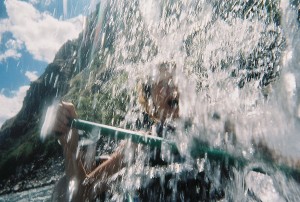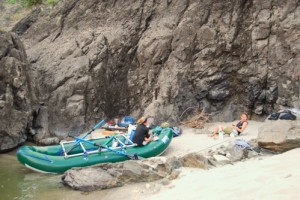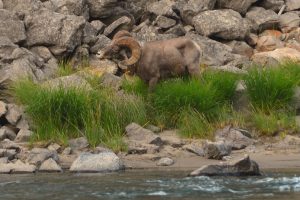Rafting the Salmon River, Idaho
by Curt Remington
A blinding flash filled the sky, lighting the inside of our tent. A loud crack followed, and thunder rocked the canyon. My daughter Heather muffled a scream. The flashes came so close together you’d think it was light out, if not

Curt & Mary just finished packing the raft
for the intense darkness between the flashes. I stared out the screen window, in case a bear would be so foolish as to venture out in this storm. Nothing seemed to be there, so I laid back down next to my wife Mary and thought about how easy our day must have been compared to my lives in the ancient Roman and Greek armies. Now that must have been tough, marching around with all that armor, fierce battles, bloody wounds, supply shortages and tents without floors. Just imagine all the insect bites.

Big snake slithering through camp
In contrast, the first day of our Salmon River rafting trip hadn’t been so bad. For my teenage daughter Heather, the excitement may have started at the Hammer Creek boat launch, where her arachnophobic “spider spotting eyes” noticed a black widow on a nearby rock. Or maybe for her, the adventure started the night before, when we arrived at a run-down motel in the middle of the night, reminding her of the “Psycho,” or the many other horror movies she’s watched. She even got to stand guard, in the fold-out bed next to the front door.

What did we get ourselves into?
Our day’s adventures also included sunny 100° heat, challenging whitewater, a broken flashlight, another big spider on our tent and a large snake that made it’s way through our camp as darkness approached. We were camped in rattlesnake country, however I believe that one was a Bullsnake. They look similar to me. This was also bear and mountain lion country, as if the spiders and snakes weren’t enough. Probably the worst hardship of the day was climbing into the tent exhausted and feeling like you’ve stepped into an oven. That 100 ̊ heat soaked into the sand all day, and our tent just held it in and radiated it back at us. Besides all that, I was sore from rowing all day.

Sunset Over Camp – Did I see a spider under that bush?
These potential dangers reminded me of how vulnerable humans are, and yet how much we can really endure. I reached over my wife, patted my daughter’s shoulder and told her that everything would be fine. The storm would be over soon. At that moment, my wife and daughter were both probably wondering why they let me talk them into this torturous trip. In my Rafting the Snake River story, I mentioned the pile of rafting gear that sat in the garage for years, due to my inability to convince my family to go on such trips. Here they were, finally facing the challenge, and how are they rewarded? Spiders, snakes, heat and a thunderstorm. Good luck getting them to go again.
Soon enough, the storm ended, and the temperature cooled down to tolerable sleeping weather.

Making our way down river
The next morning, we packed our wet sandy gear in a disorganized fashion, as items had been thrown into the nearest bag available, when the rain started. With everything packed into dry bags and strapped into place, we set off down the river to continue our 72-mile whitewater adventure.
In the morning, we set off down a dim and mysterious Cougar Canyon, where big gurgling whirlpools and swirls would suddenly form. Did I mention the giant White Sturgeon in the Salmon River, which can grow over 100 years old and reach 20 feet in length. It was easy to imagine them lurking under the swirling water of the canyon.

A Big Whitewater Hole
Along with beautiful white sand beach campsites and giant Sturgeon, the Lower Salmon River has steep canyons, thrilling rapids and calm-water stretches in-between. In the rapids, much of the goal is to avoid hitting big boulders and holes. For you non-river people, a hole (hydraulic) is created when water pours over a rock ledge and flows back at the surface, causing that frothing white turbulence. A big hole can grab hold of a raft, turn it sideways, and flip it over, as water piles down on one side while lifting up the other side. A large enough hole can also hold onto rafts and people, churning them like a washing machine. This was something we didn’t care to experience, so we diligently practiced our maneuvering skills.

Punching through a wave
Our hardest whitewater that morning goes by the name “Half and Half Rapids.” The river map warns, “So called because half the time you make it. …big holes to avoid and maneuvering is required.” We dropped down a ledge and pushed through a small hole. Quickly, we pulled hard to the left to miss a car-sized boulder and a huge hole to the right. From there, we had a bouncy ride down a string of waves.

Snow Hole Rapids- Yes, There’s a raft under them.
Three rapids later, we came to Snow Hole Rapids, a major class IV drop. Lucky for us, another group was there to scout the rapids when we arrived. We watched, as each of them hit a car-sized boulder sideways, plummeted down a drop and made their way between enormous boulders and holes, riding through rollercoaster waves.
We followed right behind, hitting a pillow of water at the top boulder. It straightened us out as we plunged down the drop. We hit some big waves and soon reached the bottom of Snow Hole, wet but safe.

Maloney Creek Camp
That night, we camped five miles into Snow Hole Canyon, at Maloney Creek. At this camp, I suggested setting up our kitchen near the river, rather than hauling all of our gear and cooler all the way up the sand dune. It saved a lot of work, kept our tent from smelling like bear bait and avoided the blowing sand that seemed to get through our tent screens.
I panned for gold, and had no luck, while Mary fished. She caught two fish with her first three casts. After one more fish, her luck slowed down. Our tent still felt hot, but the situation didn’t remind me of life in the Roman Army, that night. It seemed much more survivable.
Packing the raft went much smoother, the next day. We found ourselves working well as a team, both in camp and in the rapids. We made a smooth run down China Rapids, a tough class III, and plowed into a big wave/hole in Eagle Creek Rapids.

Salmon River Gravel Bar
A large gravel bar beckoned me, as a place to look for garnets or gems. Idaho’s nickname is the gem state after all. While I wondered in one direction, looking for agates or garnets, Heather grabbed the fishing rod and proceeded to cast. She soon had a nice sized smallmouth bass.
In the meantime, Mary used her psychic abilities to ask a spirit guide for help locating a nugget of gold. He told her to follow the shore downstream for twelve feet. His next instruction was to go inland for eight feet. Mary reached that point and looked around, asking “now what?” His final instruction was “down fifty feet.” Ha ha! Yes, spirit guides do have a sense of humor. He probably was telling the truth too. In studying prospecting, that’s just where I’d expect gold to be, at the bottom of the pile where you can’t reach it.
As we made our way down the river that afternoon, we found the nice campsites occupied by large parties of rafters. Kerry, the friend I’d rafted the Snake River with, had recommended a camp near the entrance to Blue Canyon. I really hoped to get that camp, but our chance of finding it available seemed dim. As the river narrowed, we stayed close to the cliffs on the right side of the canyon and hit a small eddy, at the bottom of a white sand beach. What a beautiful spot, and no one was there. A small alcove in the cliff made a great kitchen, with another alcove for sitting.

Comfortable Camping
That afternoon, we swam in the eddy, watched the changing light on the nearby peaks and had a delicious dinner of bass, brats and veggies. Mary and Heather laughed and screamed, running from a butterfly that followed them relentlessly. Later, we watched the changing light in the canyon and surrounding peaks, while listening to the steady sound of the rapids. For the first time, we got out our fire pan and built a small fire, sitting in one of the cliff’s alcoves. It crossed my mind, that I could almost live in that campsite.
Had conditions on the river changed that much? Or had we adapted? Our kitchen gear now sat next to the raft, and we knew where everything belonged. The tent sat pitched away from rock piles which hold the spiders and snakes. All of our gear was ready, in case of a sudden storm. Maybe the biggest change was that we’d already faced plenty of challenges on the river. We had found that we can survive, and had a great deal of fun in the process.
The final day, we worked as a team, rowing and paddling through at least 15 sets of rapids, covering 25 miles of river, with 20 of it on the Snake River. Long stretches of the Snake River were calm, with a stiff headwind. Rowing into a headwind makes a raft feel like a big, oddly shaped balloon. In other words, it’s not that much fun. We pushed on, mile after mile, with barely a complaint from anyone, taking in the scenery and enjoying the occasional rapids with some eight foot waves. We reached the takeout around five pm and loaded our gear into our truck.
It was a long hard day, once again reminding me of marching in armor, in the Roman army. But by the end of the trip, we were tougher and more up to the challenge, having learned that we can survive major rapids, spiders, snakes, thunderstorms, miles of rowing and more. Not only that, but by facing these challenges, we gained strength and confidence in our abilities. We also saw some beautiful scenery and share some wonderful time together. Maybe life in the Roman army wasn’t so bad after all.

View across from our final Salmon River camp
Powerful Being of Light Visualization Meditation
You are an eternal and powerful spiritual being. You’ve also undoubtedly endured some very difficult lives and may have been part of the Roman or Greek armies. Through life’s challenges and difficulties, we experience our greatest growth. Yet in our current life, many of us surround ourselves with modern conveniences and tend to stay well within our comfort zones, missing out on a lot of wonderful experiences. Many of us stay in a small comfort zone because we lack the confidence to push our limits.
This meditation exercise will strenghthen your sense of true inner power, providing the confidence to venture out and explore your growth zone. With this confidence, you may wish to try new things, like camping, signing up for a class or joining a new group. For me, Toastmasters and public speaking required a big push beyond my usual comfort zone.
Grounding and running your energies are an important part of this exercise and are very powerful meditation techniques that you can use every day. If you’re not familar with these exercises, please take the time to read them.
Once you’re comfortably seated, with your eyes closed and your energy running, visualize yourself as an entity of light. This is your true spiritual state. As more bright light pours in through the top of your head, feel it expand your strength and power. You might visualize yourself becoming bigger or brighter. Know and understand that as a spirit, you are eternal and powerful, capable of manifesting great things. Feel this strength continue to grow. When you finish your meditation, carry this strength with you, as you try new things and face life’s many challenges.
Warning
Although your spirit is eternal, your physical body is not. If you do not have whitewater experience, please raft with someone that does or sign up with a competent rafting outfitter. Although my family and I had not done a multi-day rafting trip together before this, I did have extensive whitewater experience. Mary and Heather had been on numerous whitewater daytrips and many camping trips.




























